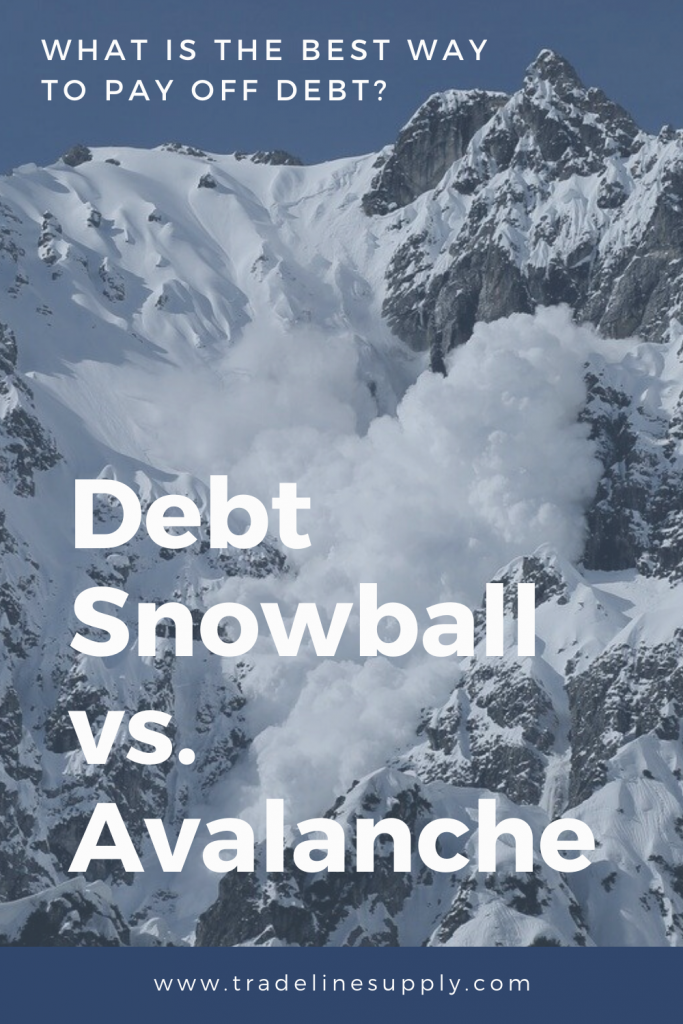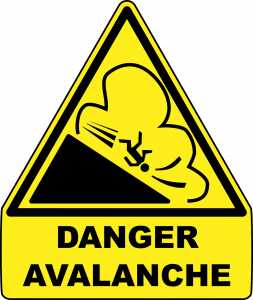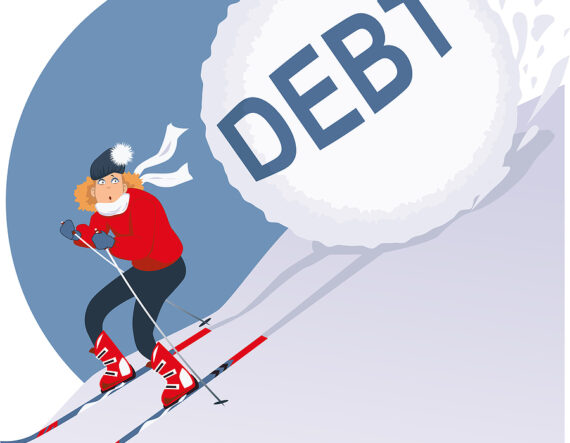Snowball vs. Avalanche: What Is the Best Way to Pay Off Debt?

Between mortgage loans, auto loans, student loans, home equity lines of credit, credit cards, personal loans, and more, Business Insider reports that the average American has $51,900 in debt.
Naturally, many people want to pay off their debt as quickly as possible. Once you are done making those hefty monthly payments, you can use your money to work for you instead of sending it out the door to your lenders.
If paying off debt is one of your financial goals, then this article is for you. We’ll be breaking down two of the most popular and effective ways of paying off debt: the debt snowball and the debt avalanche.
The Debt Snowball Method
The “debt snowball” strategy was popularized by Dave Ramsey and it is perhaps the most well-known technique for paying down debt.
How the Debt Snowball Works
The process of the debt snowball method is relatively simple. Here’s how it works:
Keep making the minimum payments on all of your debts.
Take a look at your budget and see if you can free up some funds by cutting spending or increasing your income.
Send as much money as you can toward your smallest debt until you have completely finished paying off that debt.
Once you have paid off your smallest debt, direct the money that was previously assigned to paying off that account to the next smallest account.
Repeat this process for each of your accounts in order of lowest to highest balances until you have no more debt!
Pros of the Debt Snowball Method
The debt snowball plan is not necessarily the most economically efficient, as we will discuss below, but there is a reason why it is still one of the most popular ways to gradually pay off debt.
The “debt snowball” strategy is the most popular and statistically the most successful method for paying off debt.
You get to enjoy the satisfaction of “small wins” as you pay off your lowest balances.
The effectiveness of the debt snowball approach lies in behavioral psychology rather than mathematical calculations.
When you use your resources to tackle your least intimidating debt first, it won’t be long before you can celebrate a small victory, and then another, and then another. This provides encouragement and motivation to keep going, which is a vital factor in the long-term sustainability of your plan.
You can quickly make progress on freeing up cash flow to direct toward other debts.
Every time you knock out a small debt, you can use the money that you were putting toward that bill to attack the next one, increasing your momentum with each debt that you finish paying off.
The debt snowball has the highest success rate.
Many financial experts recommend the debt snowball option because statistically, consumers are more likely to stay on track with their goals when they use the snowball approach, which is due to its powerful psychologically motivating effect.
Cons of the Debt Snowball Method
You will pay more in interest charges.
With the debt snowball option, since you are attacking your debts in order of their outstanding balances without considering their interest rates, it is likely that you will end up paying more in interest than if you were to work in order of the debt with the highest interest rate first to the debt with the lowest interest rate last.
It will likely take longer to pay off your debt.
Similarly, since you will be starting small and paying more money in interest overall, it could take longer to become debt-free than if you were to use a mathematically more efficient method.
The Debt Avalanche Method
The debt avalanche method is technically the faster and more economical approach to getting rid of your debt.
The debt avalanche, on the other hand, is all about the numbers. This path aims to reduce the amount of interest you pay so that you can pay off your debt faster and pay less money overall.
How The Debt Avalanche Works
The debt avalanche is very similar to the snowball strategy. The only difference is the order in which you pay off each debt. The process follows these steps:
Keep making the minimum payments on all of your debts.
Send as much money as you can toward the account that has the highest interest rate.
Keep doing this until the account is paid off.
Take the money that was going toward that account and add it to your monthly payment toward the account with the second-highest interest rate until you eliminate the balance on that debt.
Repeat this process until your debt is gone!
Pros of the Debt Avalanche Method
Without the psychological motivation of “small wins” at the beginning, the debt avalanche plan tends to be less effective because it is harder to stick to than the snowball method.
You will pay less in interest.
Since you are tackling the debts with the highest interest rates first, you will be able to wipe out the most expensive debt more quickly than if you were to prioritize the size of the balance instead.
The debt avalanche helps you get rid of your debt sooner.
Again, starting with the highest interest rates means you won’t have to deal with those high interest charges continually piling on as you pay off other accounts. Less interest means a lower total amount owed, so you could reach your goal faster with this method.
Cons of the Debt Avalanche Method
It might take a while to feel like you are making progress.
With the debt avalanche, you may not be starting with a small debt, so you might not get the chance to celebrate some small wins early on that you could get with the snowball approach. This is especially true if your higher interest rate debts are also your accounts with high balances. It could take a long time to finish paying off just one account.
It doesn’t account for emotions about money and debt.
While the debt snowball is meant to keep you going by providing quick emotional boosts, the debt avalanche focuses purely on the numbers. Calculations of how much you could save on interest may not be as exciting or motivating as the prospect of knocking out smaller accounts.
The fact that people tend to have strong feelings about money is not necessarily accounted for in the debt avalanche plan.
The debt avalanche is harder to stick to long-term.
Due to the above factors, the debt avalanche method can feel discouraging to some consumers. If it’s hard to see the dent you are making in your debt, you are more likely to give up on your goals and land right back where you started. As we mentioned above, the debt snowball tends to have a higher success rate than the debt avalanche.
Snowball vs. Avalanche Debt Payoff Calculator
Perhaps by this point, it is still not clear which of these two methods would work best for you. One tool that may be useful in making your decision is a calculator that can show you how much you will pay back in total and how long it will take you to get out of debt with both methods so that you can compare the results side by side.
To use a snowball vs. avalanche calculator, such as this one from MagnifyMoney, you will need to have the following information on hand to put into the calculator:
A debt snowball vs. avalanche calculator can help you determine the best approach for you.
The balance of each of your accounts
The APR of each account
The amount of the minimum monthly payment you make toward each account
The total dollar amount that you can afford to pay toward your debt every month
Once you input your information and get your results from the calculator, you will have a clearer comparison of the two methods in numerical terms.
A Hybrid Approach
A third option is to use a combination of the two strategies to get the benefits of each.
For example, you could first focus on accounts with significantly higher interest rates than your other accounts, such as credit cards, like you would with the avalanche method.
Then, once you are finished with those, you could proceed to pay off the rest of your accounts with lower interest rates in order of smallest to largest outstanding balances. Since these accounts will all have relatively low interest rates, this way, you can still hit some of those smaller goals without sacrificing too much money in terms of interest.
Another potential benefit to this approach is that focusing on paying off your credit cards first can help your credit score rebound sooner, since revolving debt balances are far more damaging to your credit score than installment debt balances.
Summary: What Is the Best Way to Pay Off Debt?
When it comes to paying off debt, there is no easy, one size fits all answer. The best path forward depends not just on the nuts and bolts of your finances, but also your personality, behaviors, and motivations.
The debt snowball is a popular option that works well for many because the quick feeling of success each time you pay off a small debt can help keep you inspired to stay on track. The downside of this method is that you could pay more in interest and spend a longer period of time chipping away at your debt.
If you would rather minimize interest charges and speed up the process, and you don’t need those psychological boosts, then the avalanche method may work for you. However, keep in mind that not everyone has the discipline to stick with the debt avalanche for as long as it takes to see results.
You can also get creative and modify or combine the two approaches in a way that makes sense for your financial situation and your personality.
In addition, your debt payoff plan—no matter which method you choose—will only help you if you commit to getting and staying out of debt. If you are still spending too much and accumulating more debt, then you won’t get anywhere, even with the most powerful debt payoff strategies.
Ultimately, the best way to pay off debt is to choose a plan that you can stick to. The most important thing is to be able to reach your destination of becoming debt-free, regardless of which path you choose.
Read more: tradelinesupply.com
















